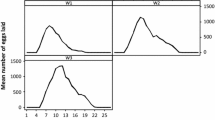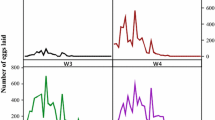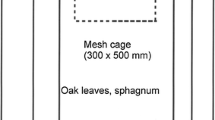Abstract
A colony ofAmblyomma parvum was started with engorged females collected from cattle in the Province of Salta (25°01′ S, 63°56′ W), Argentina. The progeny of those ticks were fed on rabbits and the non-parasitic stages maintained at 27±1°C, 83–86% RH in darkness. The life cycle (prefeeding period not evaluated) had a mean duration of 99.6 days. The mean time (days) for the different phases of the cycle were as follows: feeding period of females, 8.0; pre-oviposition period, 5.7; oviposition period, 17.5; minimum incubation period of the eggs, 31.8; feeding period of larvae, 3.2; premoult period to nymphs, 10.9; feeding period of nymphs, 4.7; premoult period to adults, 17.8. The oviposition pattern was typical of an ixodid tick, including a linear relationship between weights of engorged females and the number of eggs laid (r=0.8659). The males increased 18% in weight after feeding on hosts (P<0.01). The mean recovery rates of larvae, nymphs and females were 28.2%, 95.3% and 90.7%, respectively. The nymphs moulting to females were heavier (6.8±0.69 mg) than those moulting to males (3.2±0.29 mg) (P<0.01). A comparison of biological values ofA. parvum with American and non-AmericanAmblyomma species is presented.
Similar content being viewed by others
References
Bailey, K.P., 1960. Notes on the rearing ofRhipicephalus appendiculatus and their infection withTheileria for experimental transmission. Bull. Epizoot. Dis. Afr., 8: 33–43.
Balashov, Yu.S., 1972. Blood sucking ticks (Ixodoidea) vectors of diseases of man and animals. Misc. Publ. Entomol. Soc. Am., 8: 161–376.
Bhat, H.R., 1978. Life-history ofAmblyomma integrum Karsch 1879 (Acarina: Ixodidae). Indian J. Anim. Sci., 48: 821–825.
Cooney, J.C. and Hays, K.L., 1972. Bionomics of the gopher tortoise tick,Amblyomma tuberculatum Marx. J. Med. Entomol., 9: 239–245.
Drummond, R.O. and Whetstone, T.M., 1970. Oviposition of the Gulf Coast tick. J. Econ. Entomol., 63: 1547–1551.
Drummond, R.O. and Whetstone, T.M., 1975. Oviposition of the Cayenne tick,Amblyomma cajennense (F.), in the laboratory. J. Econ. Entomol., 68: 214–216.
Drummond, R.O., Whetstone, T.M. and Gladney, W.J., 1971. Oviposition of the lone star tick. J. Econ. Entomol., 64: 191–194.
Garris, G.I., 1984. Colonization and life cycle ofAmblyomma variegatum (Acari: Ixodidae) in the laboratory in Puerto Rico. J. Med. Entomol., 21: 86–90.
Gladney, W.J., 1971. Mate seeking by femaleAmblyomma maculatum (Acarina: Ixodidae) on a bovine. Nature, 232: 401–402.
Gladney, W.J. and Drummond, R.O., 1970. Mating behaviour and preservation of the lone star tick,Amblyomma americanum (L). Ann. Entomol. Soc. Am., 66: 1093–1097.
Gladney, W.J., Dawkins, C.C. and Price, M.A., 1977.Amblyomma inornatum (Acarina: Ixodidae): natural hosts and laboratory biology. J. Med. Entomol., 14: 85–88.
Guglielmone, A.A. and Moorhouse, D.E., 1983. Compulation and successful insemination by unfedAmblyomma triguttatum triguttatum Koch. J. Parasitol., 69: 786–787.
Guglielmone, A.A. and Moorhouse, D.E., 1985. Differences in nymphs ofAmblyomma triguttatum triguttatum Koch moulting to males or females. Acarologia, 26: 7–11.
Guglielmone, A.A. and Moorhouse, D.E., 1986. Reproduction inAmblyomma triguttatum triguttatum Koch. Acarologia, 27: 235–239.
Guglielmone, A.A., Mangold, A.J., Gaido, A.B. and de Olsen, A.A., 1989. The effect of infection byBabesia sp. on some biological parameters of engorged females ofBoophilus microplus. Folia Parasitol., 36: 1–6.
Guglielmone, A.A., Mangold, A.J. and Keirans, J.E., 1990a. Redescription of the male and female ofAmblyomma parvum, Aragao 1908, and description of the nymph and larva, and description of all stages ofAmblyomma pseudoparvum sp. n. (Acari: Ixodida: Ixodidae). Acarologia, 31: 144–159.
Guglielmone, A.A., Mangold, A.J., Aguirre, D.H. and Gaido, A.B., 1990b. Ecological aspects of four species of ticks found on cattle in Salta, Argentina. Vet. Parasitol., 35: 93–101.
Hoogstraal, H., 1978. Biology of ticks. In: J.K.H. de Wilde (Editor), Proceedings of an International Conference, 27 September–1 October 1976, Edinburgh. University of Edinburgh, Center Tropical Veterinary Medicine, pp. 3–14.
Koch, H.G., 1981. Suitability of birds and mammals as hosts for immature stages of the lone star tick,Amblyomma americanum (Acarina: Ixodidae). J. Med. Entomol., 18: 93–98.
Norval, R.A.I., 1974. The life cycle ofAmblyomma hebraeum Koch, 1844 (Acarina: Ixodidae). J. Entomol. Soc. South. Afr., 37: 357–367.
Norval, R.A.I. and Capitini, L.A., 1974. The rate of feeding, and spermatogenesis inAmblyomma hebraeum Koch, 1844 (Acarina: Ixodidae). J. Entomol. Soc. South. Afr., 37: 393–401.
Norval, R.A.I., Colborne, J. and Mackenzie, P.K.I., 1980. The life cycle ofAmblyomma tholloni Neumann, 1899 (Acarina: Ixodidae) under laboratory conditions. Vet. Parasitol., 7: 255–263.
Ouhelli, H. and Pandey, V.S., 1984. Development ofHyalomma lusitanicum under laboratory conditions. Vet. Parasitol., 15: 57–66.
Rechav, Y. and Knight, M.M., 1981. Life cycle in the laboratory and seasonal activity of the tickRhipicephalus glabroscutatum (Acarina: Ixodidae). J. Parasitol., 67: 85–89.
Rechav, Y. and Knight, M.M., 1983. Life cycle ofRhipicephalus oculatus (Acarina: Ixodidae) in the laboratory. Ann. Entomol. Soc. Am., 76: 470–472.
Rechav, Y. and Oppenheim, J., 1969. Feeding and fertilizing capacity in male ticks of the speciesHyalomma excavatum (Koch 1844). Refu. Vet., 26: 71–74.
Snow, K.R. and Arthur, D.R., 1966. Oviposition ofHyalomma anatolicum anatolicum (Koch, 1844) (Ixodidae: Ixodidae). Parasitology, 56: 555–568.
Von Centurier, C. and Klima, R., 1979. Ein Beitrag zur Kenntnis der Biologie vonAmblyomma variegatum (Fabricius, 1794). Z. Angew. Entomol., 87: 131–142.
Author information
Authors and Affiliations
Rights and permissions
About this article
Cite this article
Guglielmone, A.A., Mangold, A.J. & Garcia, M.D. The life cycle ofAmblyomma parvum Aragao, 1908 (Acari: Ixodidae) under laboratory conditions. Exp Appl Acarol 13, 129–136 (1991). https://doi.org/10.1007/BF01193663
Accepted:
Issue Date:
DOI: https://doi.org/10.1007/BF01193663




